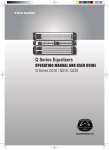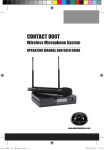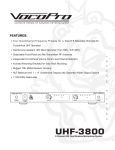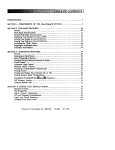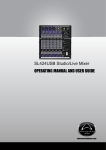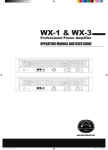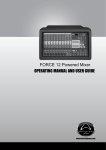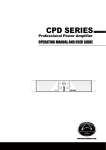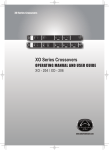Download Wharfedale Pro CONTACT 502A User guide
Transcript
CONTACT 502A Wireless Microphone System OPERATING MANUAL AND USER GUIDE www.wharfedalepro.com OPERATING MANUAL IMPORTANT WARNINGS & SAFETY INSTRUCTIONS 1. 2. 3. 4. 5. 6. 7. 8. 9. 10. 11. 12. Please read and retain these safety instructions. Heed all warnings in the operating instructions and on the appliance. Do not use this apparatus near water or moisture. Clean only with a dry cloth. Do not install near sources of heat such as radiators, heat registers, stoves or other apparatus that produce heat. Refer all servicing to authorised personnel. There are no user serviceable parts inside this product. Users should not attempt to service this product. Warranty nullification could result if this is attempted. Servicing is required when the apparatus has been damaged in any way including: Impact damage, power cord/supply damage, liquid spillages, small objects falling into the unit or exposure to moisture. In addition please refer to authorised service personnel if the apparatus is not operating normally. To completely disconnect this equipment from the AC mains disconnect the power plug from the AC receptacle. To prevent fire never place the unit near any naked flame such as a candle. Do not defeat the purpose of the polarized or grounding type plug. A polarized plug has two blades with one wider than the other. A grounding type plug has two blades and a third grounding prong. The wide blade or the third prong are there for your safety. If the plug does not fit into your outlet, consult an electrician for replacement of the obsolete outlet. USING AMPLIFIERS – In order to avoid damage to drivers and other equipment, it is advisable to establish and follow a routine for powering up and powering down a sound system. With all system components connected, turn on source equipment (mixers, signal processors, record and playback Contact 502A 13. 14. 15. units, etc.) BEFORE powering up amplifiers. Transient voltages from powering up source equipment can damage speakers if amplifiers are already turned on. Make sure that amplifier volumes are set to their minimum settings and power up any system amplifiers LAST. It is recommended that all system components be allowed to stabilize for several seconds before any source signals are introduced or level setting adjustments are made. Similarly, when shutting systems down, turn all amplifiers off first, before powering down any other system components. CABLES – Do not use shielded or microphone cables for connection between amplifiers and speakers. Use only approved speaker cables with proper connectors. R I G G I N G – SU S PEN D I N G – M O U N TI N G – R i g ging, suspending and mounting of speaker systems can expose members of the public to serious health risks and even death. U N D ER N O CIRCU M STA N CES AT TEM PT TO RIG, SUSPEN D O R OTH ERWISE M OU NT SOU N D REINFORCEMENT PRODUCTS UNLESS YOU ARE FULLY QUALIFIED AND CERTIFIED TO DO SO BY RELEVANT L O C A L , S TAT E A N D N AT I O N A L A U T H O R I T I E S . A L L R ELE VA N T S A FE T Y R EG U L ATI O N S M U ST B E FOLLOWED. IF YOU ARE NOT PROPERLY QUALIFIED OR DO NOT KNOW OF PERTINENT REGUL ATIONS, CONSULT QUALIFIED PERSONNEL FOR ADVICE. CAUTION – Professional sound reinforcement systems are capable of generating very high sound pressure levels. Take care with placement and operation to avoid exposure to excessive volume levels. Permanent hearing damage can result when operated to extreme levels. OPERATING MANUAL TABLE OF CONTENTS Important Warnings and Safety Instructions......................... 1 Introduction............................................................................. 4 Overview................................................................................. 4 Features and contents............................................................ 5 Setting up the receiver........................................................... 8 Receiver operation................................................................. 9 Receiver controls.................................................................... 9 Placement of the Receiver................................................... 10 Notice.................................................................................... 11 Names and Functions........................................................... 11 Battery installation................................................................ 12 Specification......................................................................... 13 Warranty............................................................................... 14 Contact 502A INTRODUCTION Wharfedale Contact 502A Wireless microphones are the result of many years of experience in the use, design and manufacturing of professional audio products.We take great pride in engineering and building ever y Whar fedale Pro microphone and wish to thank you for entrusting us with your sound. Please take a few minutes to read this manual completely in order to ensure that you get the most out of your Contact 502A Wireless microphone. CONTACT 502A OVERVIEW: Thank you for selecting the Contact 502A dual-channel UHF wireless microphone system. This system can receive signals from two microphones simultaneously. It uses digital circuitry to distinguish the intensity of the signals received by the two antennas. Each channel has a volume control, function buttons and is controlled by a dedicated CPU. An LED display Shows information for each channel. Function buttons include: GROUP, SCAN and SYNC. T he SY N C but ton allows t he user to quic k ly lo c k t he receiving and transmitting frequencies of the microphone transmitter system. The Contact 502A can seamlessly change frequencies quickly and select compatible channels without the need to mute mixer channels or output devices. The Contact 502A is packaged in a 1U rack mount chassis. OPERATING MANUAL FEATURES • Antenna diversity system with 2 antennas • High sensitivity handheld dynamic microphones with integrated transmitters • Infrared link for automatic synchronisation of transmitters and receiver • Automatic scanning for interference free channels • Intelligent battery status display for each channel • Up to 8 hours of continuous use from 2x AA batteries • Automatic microphone off in low battery conditions • Worldwide multi-voltage switching power supply CONTENTS 1 x Wireless receiver 2 x Antennas 2 x Dynamic microphones with built in transmitters 2 x ¼” jack cables 1 x Power supply 1 x User manual 4 x AA batteries 1 x Rack mount kit Contact 502A FRONT PANEL OF THE DUAL CHANNEL RECEIVER: Fig.1 1) 2) POWER: Toggles the power on and off. VOLUME CONTROL (Channels A & B): Sets the level for each channel. 3) G R O U P ( C h a n n e l s A & B ) : C r e a t e g r o u p s o f microphones, which is useful when many microphones are used simultaneously. 4) LED (Channels A & B): Displays the GROUP and CHANNEL assignment for each channel. 5) RF LED (Channels A & B): Indicates that RF signal is present and locked. 6) AF LED (Channels A & B): Indicates that audio signal is present. 7) SCAN (Channels A & B): Initiates scanning for a new channel. Automatically scans and locks on to compatible interference free channels. 8) SYNC (Channels A & B): Synchronises the transmitter to the receiver. 9) IR SYNC receiver: Receives the IR SYNC signal from the base of the transmitter. 10) Receiver Frequency Codes. (See page 14, III Frequency Range Code Table) 11) Rack ears: Used to fix the receiver to a standard 19’’ equipment rack. OPERATING MANUAL REAR PANEL OF THE DUAL CHANNEL RECEIVER: Fig.2 12) Antenna Connectors 13) Output B: ¼” unbalanced jack output connector for CH B. 14) O U T PU T M O D E S w i tc h: U s e “ M I X ED ” to o u t p u t both microphones from output A. Use “SEPAR ATE” to output each microphone individually. 15) Output A: ¼” unbalanced jack output connector for CH A or the mixed signal. 16) Output Level Switch: Use “MIC” when connected to microphone inputs (-14dBv/ 100Ω). Use “LINE” when connected to line level inputs (+4dBv/ 5kΩ). 17) LOCK: When engaged all front panel but tons are disabled. The power switch will continue to function even when the unit is locked. 18) SQUELCH B: Adjusts the sensitivity of Channel B to reduce noise. 19) SQUELCH A: Adjusts the sensitivity of Channel A to reduce noise. 20) DC Power receptacle: For connecting the external 13V DC power supply (centre pin positive). Contact 502A SETTING UP THE RECEIVER Output connection: Fig.3 Fig.3a 1. 2. 3. 4. Install the two antennas on the rear panel as shown in Fig.3a. Connect the power supply as shown in Fig.3. (Caution: Ensure the power supply has the correct rating for your local AC supply) Connect audio leads from the output of each channel to an input on a mixer or powered speaker. When the output cable is connected to an auxiliary or line input the “OUTPUT LEVEL” switch (16) should be set to the “LINE” position. When the output cable is connected to a microphone input of a mixer or powered loudspeaker the “OUTPUT LEVEL” switch should be set to the “MIC” position. If the “LEVEL” switch is set in the wrong position the gain structure will be wrong and can cause excessive hiss or distortion. When the “OUTPUT MODE” switch (14) is set to “MIXED” only connect to “OUTPUT A” (13). There is no output from “OUTPUT B” in this mode. OPERATING MANUAL RECEIVER OPERATION: 1 2. Before tur ning on the rec eiver, make c er t ain the transmitter is off. Also ensure that the volume for CH A and CH B are set to minimum. Ensure that your output devices are muted or set to the lowest possible level before turning on the Contact 502A, then hold down the power button of the receiver until the LED displays illuminate. Turn on the wireless microphone. The RF indicator light of the corresponding channel will illuminate. Turn the volume of the receiver to 12 o’clock. Raise the level of your output devices and then speak into the microphone. The AF indicator LED on the receiver will illuminate with the volume level. RECEIVER CONTROLS 1. 2. 3. 4. Upon power up the LED fully illuminates and displays the GROUP and CHANNEL information. GROUP function: Press the GROUP but ton once. The group number will flash; it shows that the GROUP is pending. Press the Group button to increment the GROUP numbers from 1-9. Stop at the desired number to assign to the group. CHANNEL function: press the SCAN button once. The channel numbers flash showing the channel is pending. Press it again to increment the numbers. Stop at the desired number to assign the channel. SYNC function: Press the SYNC button once and move the powered-up microphone about 30 cm in front of the receiver. Point the power indicator of the microphone at the transmitting window of the receiver. When the channel locks, the LCD will display the same group and channel as the receiver. Synchronisation is now complete. Contact 502A 5. 6. LOCK and UNLOCK: If you wish to lock the controls on the front panel to avoid accidental adjustments, set the “LOCK/UNLOCK” switch (17) to the “LOCK” position. All the buttons will be disabled except the “POWER” button. To enable the front panel controls slide the switch to the “UNLOCK” position. SQUELCH: There are two adjustable SQUELCH controls on the rear panel of the receiver. The SQUELCH value of the A and B channel should be adjusted to improve sound quality, and can be used to minimise unwanted hiss or distrortion. PLACEMENT OF THE RECEIVER 1. In order to achieve the best results, the receiver should Have a minimum 1 metre clearance on all sides from the floor or walls. The distance between the transmitter and antenna should be over 1 metre, as in Fig. 4. The receiver should be kept away from sources of possible interference. Fig.4 2. The receiver can be mounted in a EIA standard 19 inch (482.6mm) rack. Use the supplied rack ears as per Fig. 5. Fig.5 10 OPERATING MANUAL NOTICE: • The position of the antenna will affect the reception, so minimise the distance between the microphone and receiver where possible. • Several sets of wireless microphones can be used simultaneously with this system. Please consult your dealer or distributor for correct frequencies. NAMES AND FUNCTIONS: 1. 2. 3. 4. 5. 6. Pop shield: Protects the microphone capsule from damage and reduces the “pop” noise (from “P’s” and “B's”) as well as wind noise. Barrel: Contains the transmitter circuitry. Battery Compartment: houses two AA type batteries. Transmitter codes. LCD panel: Displays the transmitter information. SYNC signal IR transmitter: transmits SYNC information, self-adjusts frequency and transmitting power. Fig.6 11 Contact 502A BATTERY INSTALLATION Fig.7 1 2. 3. 4. Unscrew the upper par t (2) of the microphone in a counter-clockwise direction Install the two AA batteries according to the polarity as shown in the battery compartment, and screw the upper part tight. Operating Functions of the LCD Panel 1) When the power switch is in position 1, the LCD displays all the content, then displays the power value for a second. 2) Bat ter y Status: When the bat ter y level is 10%, batteries should be replaced. When the battery level is 0%, the LCD battery level and the power supply indicator will flash to remind you again to change batteries. If the battery level is too low for a long time, the LCD will display “Po OFF” and turn off the microphone. Turnoff: 1) When the power supply is switched to “O”, the LCD will display “Po OFF”, which indicates it will turn off soon, and then the power supply will automatically shut down. 12 OPERATING MANUAL NOTE: When the microphone is not in use, remember to turn off the power supply. If you will not use the microphone for a long time, remove the batteries to avoid damage from battery leakage. If you are using rechargeable batteries, remove the batteries and charge them in their charger. SPECIFICATIONS I. Receiver Cabinet Size Channels Receiving Manner Oscillation Mode Carrier Frequency Range Stability Bandwidth Sensitivity Frequency Interval Switched Frequencies S/N T.H.D. Frequency Response Functional Distance EIA Standard 1U Two Channel Automatic via Antenna PLL (Phase Locked Loop), frequency compounded. UHF 529~865MHz ±0.005%(-10~50 ºC) 13MHz 4μV (S/N>12dB 25KHz deviation) 250KHz 50 channel ≤90dB(A) < 1% at 1KHz 60 - 15KHz (±3dB) 80 meters Line of Sight Note: Ac tual range depends on RF signal absorption, reflection and interference. Max. Output Level Output Jack AC Power Supply DC Power Supply Dimensions (mm) 13 -14dBV/5kΩ 6.3mm (1/4”) Phone jack External 110-220VAC 0.5A, 13 - 15VDC 420 x 195 x 44mm Contact 502A II. Transmitter Oscillation Mode Carrier frequency Frequency Stability Bandwidth Frequency Adjustment Output Power Harmonic radiation Max. adjustment range Max. Input SPL Battery PLL (Phase Locked Loop) frequency Compounded UHF 529 ~ 865MHz ±0.005% (-10 ~ 50 ºC) 13MHz Automatic Channel setting > 10dBm (adjustable) < 55 dB(c) ± 48kHz 140dB AA battery x 2 III. Frequency Range Code Table. Receiving Frequency Ranges Transmitting Frequency Ranges Transmitting Frequency Ranges Code Frequency Code Frequency Code Frequency Range(MHz) Range(MHz) Range(MHz) F1 529 – 596 F2 659 – 696 F3 713 – 752 F4 780 – 806 F5 838 – 865 F1A 529 – 542 F2A 659 – 662 F3A 713 – 726 F4A 780 – 793 F5A 838 – 841 F1B 583 – 596 F2B 683 – 696 F3B 740 – 752 F4B 793 – 806 F5B 852 – 865 WHARFEDALE PRO LIMITED WARRANTY Wharfedale Pro Contact 502A Wireless Microphone Systems are warranted of manufacturing or material defects for a period of one year from the original date of purchase. In the event of malfunction, contact your authorised Wharfedale Pro dealer or distributor for information. * Be aware that warranty details may differ from country to country.Contact your dealers or distributor for information. These terms do not infringe your statutory rights. 14 WharfedaleProfessional IAG House, 13/14 Glebe Road, Huntingdon, Cambridgeshire, PE29 7DL, UK www.wharfedalepro.com WharfedaleProfessionalreservestherighttoalter or improve speci ications without notice. Allrightsreserved©2010WharfedalePro. WharfedaleProisamemberoftheIAGGroup.
















